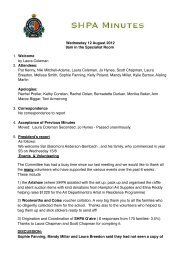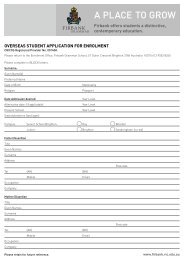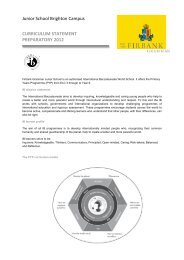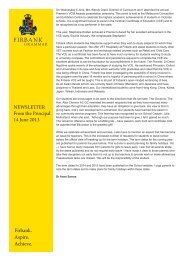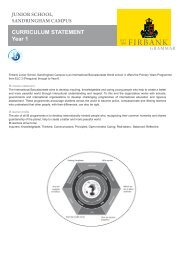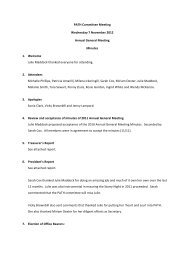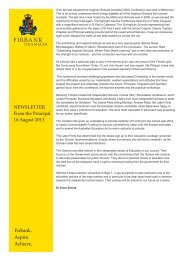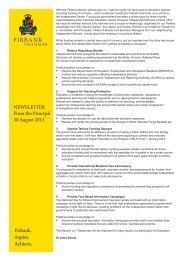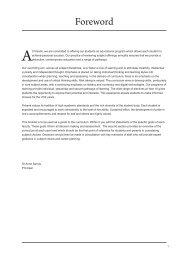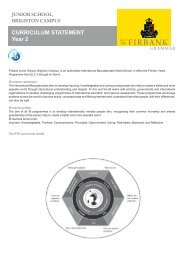CURRICULUM STATEMENT Preparatory - Firbank Grammar School
CURRICULUM STATEMENT Preparatory - Firbank Grammar School
CURRICULUM STATEMENT Preparatory - Firbank Grammar School
You also want an ePaper? Increase the reach of your titles
YUMPU automatically turns print PDFs into web optimized ePapers that Google loves.
JUNIOR SCHOOL,SANDRINGHAM CAMPUS<strong>CURRICULUM</strong> <strong>STATEMENT</strong><strong>Preparatory</strong>EST1909FIRBANKGRAMMAR<strong>Firbank</strong> Junior <strong>School</strong>, Sandringham Campus is an International Baccalaureate World school. It offers the Primary Years Programmefrom ELC 3 (Penguins) through to Year 6.IB mission statementThe International Baccalaureate aims to develop inquiring, knowledgeable and caring young people who help to create a better andmore peaceful world through intercultural understanding and respect. To this end the organization works with schools, governmentsand international organizations to develop challenging programmes of international education and rigorous assessment. Theseprogrammes encourage students across the world to become active, compassionate and lifelong learners who understand that otherpeople, with their differences, can also be right.IB learner profileThe aim of all IB programmes is to develop internationally minded people who, recognizing their common humanity and sharedguardianship of the planet, help to create a better and more peaceful world.IB learners strive to be:Inquirers; Knowledgeable; Thinkers; Communicators; Principled; Open-minded; Caring; Risk-takers; Balanced; Reflective.
Program of Inquiry (POI)As far as possible all subject areas relate to the Programme of Inquiry. Over the course of a year each Grade Level does six Units of Inquiry, onefrom each Transdisciplinary Theme. Prep units are:Transdisciplinary Theme:Where we are in place andtimeTransdisciplinary Theme:Who we areCentral Idea:Sharing our personalhistories helps us tocelebrate who we are andwhere we come from.Central Idea:In order to be safe we needto be aware of the dangersin our environment.Lines of inquiry: • Ways of documentingour personal history• Reflecting on pastexperiences• The connection betweenour past and nowLines of inquiry: • The dangers that existinside our homes• The dangers that existin our environment• Identifying andavoiding dangersConceptsConnectionReflectionConceptsCausationResponsibilityTransdisciplinary Theme: Sharing the planet Transdisciplinary Theme: How the world worksCentral Idea:Human behaviour andactions affect the world’soceans and the creaturesthat live in them.Central Idea:Every day we changematter from one state toanother.Lines of inquiry: • Human actions thataffect our oceans• Our responsibility tomaintain our oceans• Interdependence in theoceansLines of inquiry: • How matter isclassified• How matter changesstate and why• How changing matterhelps us to performeveryday tasksConcepts Causation, Responsibility Concepts Form, ChangeTransdisciplinary Theme: How we organise ourselves Transdisciplinary Theme: How we express ourselvesCentral Idea:Most products are an endresult of a processLines of inquiry: • Products we use• Where products comefrom• The stages products gothroughCentral Idea:Stories can stimulate ourimaginations.Lines of inquiry: • The form of stories• How we use ourimagination• How we can expressour imaginationthrough storiesConceptsFunctionConnectionConceptsFormPerspective
LanguageWritingThroughout the year, Prep students will be encouraged to write lower case letters legibly with consistent size and placement. They willwrite short sequenced texts that include some related ideas about familiar topics and for a variety of purposes. They will also write simplesequenced stories with a beginning, middle and end. The students will be encouraged to begin to re-read their own writing. Within theirwriting they will begin to spell high frequency words more accurately and use simple spelling patterns or spell phonetically. They will moreconsistently use capital letters, full stops and question marks.ReadingAt the end of Prep students should be able to match sounds accurately to a range of letters and letter clusters. They read simple textswith developing confidence and pleasure and will more consistently use a range of strategies to work out the meaning of unfamiliar wordsin context. For example; sounding out, re-reading and using cues from illustrations. Students will begin to use self-correction techniquesand punctuation to contribute to meaning when reading aloud, eg. Recognition of quotation marks to identify a speaker’s words. They willgive an ordered retelling of main ideas from a text they have read and predict plausible ending for stories, showing increased awarenessof characters and plot.Speaking and ListeningThe Prep students are continuously encouraged to discuss their thoughts, feelings and opinions on a variety of issues throughoutthe year. In doing so they are reminded to speak at an appropriate volume and pace for listeners needs. Listening to others andresponding appropriately to what has been said is expected at this level. The students will begin to follow and complete more detailedinstructions. After listening to a speaker they will recall some of the main ideas and information presented. When working in groups,making appropriate comments and asking appropriate questions is promoted and encouraged.VisualPrep children will understand that communication involves verbal, visual and kinaesthetic modes. The children will become more awareof their surroundings recognising the meaning of signs and symbols within this. They will demonstrate an increased awareness of textswith different types and layouts and know how to make sense of them.MathematicsNumberStudents will read, write, estimate, count, and order numbers to 100. They will read, write, model and understand addition and subtractionand the strategies of counting on and back. They will develop strategies to automatically solve addition facts to 10. They will exploremultiplication and division using concrete materials and explore the counting patterns of 2, 5 and 10.MeasurementStudents will estimate, measure, label, and compare using non-standard units of measurement and understand why we use standardunits of measurement to measure length, mass, capacity, time and temperature. The students will be introduced to formal units ofmeasurement. They will read and write time to the hour and half hour and learn simple rhymes to help them recall the sequence of daysof the week and months of the year.Shape and spaceStudents will sort and label 2D and 3D shapes using appropriate mathematical vocabulary. They will find and explain symmetry in theirimmediate environment and apply this knowledge in a practical way.Data handling, statistics and probabilityStudents will sort, label, collect and compare data in a variety of forms, including pictographs and bar graphs. They will understand thepurpose of graphing data. They will discuss, identify, predict and place outcomes in order of likelihood.
ArtA PYP visual arts classroom will further develop a student’s understanding of the central idea of many units of inquiry by linking thecreative disciplines of visual arts to other disciplines. Sometimes the visual arts program will build on its own lines of inquiry. Studentsin Prep will draw upon their imagination and experiences to express their feelings and stories through art expression. They will beintroduced to several art forms including printmaking (mono-prints), textiles, drawing, painting, modelling (clay), and puppet making.Students will begin to formulate understandings about the elements of colour, line, shape and texture through the exploration of a varietyof art materials and tools. They will work both independently and in pairings to explore and trial these art materials and tools. They willbe exposed to art forms associated with special events such as celebrations around the world. They will begin to make short statementsabout their work.Mandarin<strong>Firbank</strong> is introducing Mandarin (Chinese) as an additional language from 2011. All learners benefit from having access to differentlanguage and as a consequence, access to different cultures and perspectives. Communication skills in a language other than Englishfoster intercultural knowledge and awareness of language as a system. Students will develop skills of listening, speaking, reading, viewing,writing and the use of body language , visual cues and signs. The intercultural knowledge and language awareness dimension developsstudents’ knowledge of the connections between language and culture, and how culture is embedded throughout the communicationsystem. The understandings are universal and are gained by comparing languages, including English.LibraryStudents will visit the Jill Forster Resource Library for a weekly lesson. During library time they are exposed to a variety of texts encouraginga love of reading. Students are given the opportunity to change books weekly.MusicIn Prep are exposed to the main elements of music; beat(regular), pitch(me so la and high /low), tempo(fast/slow), dynamics(loud/soft),tone colour(sounds of different percussion instruments), texture(thick and thin) form(different sections and phrases) and style(songs forcelebrations and music that tells a story). Singing lies in the heart of the curriculum where students display confidence and expression.Students play musical pieces using a range of percussion instruments. They perform solo and as part of an ensemble for a variety ofaudiences. Students use their imagination and musical experience to organise sounds into various forms that communicate specific ideasand moods. They use non-traditional and traditional notation to record their compositions. Students are given the opportunity to hear thenidentify and describe various musical elements. They distinguish the different tone colour of instruments and respond to a wide and variedrepertoire of musical styles as well as to music from different times and cultures.Physical EducationPhysical Education within Prep offers the children the opportunity to perform basic motor skills and movement patterns, with or withoutequipment, in a range of environments. They regularly engage in periods of moderate to vigorous physical activity. They use simplevocabulary to describe movement, the physical responses of their bodies to activity and their feelings about participation in physicalactivity. When participating in movement and physical activities, they follow rules and procedures and share equipment and space safely.The children will be more aware of safe behaviour practices and begin to understand the importance of fair play, co-operative behavioursand the ability to function as part of a group.



